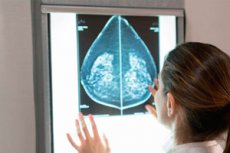New publications
Study finds increased risk of secondary cancer in breast cancer survivors
Last reviewed: 02.07.2025

All iLive content is medically reviewed or fact checked to ensure as much factual accuracy as possible.
We have strict sourcing guidelines and only link to reputable media sites, academic research institutions and, whenever possible, medically peer reviewed studies. Note that the numbers in parentheses ([1], [2], etc.) are clickable links to these studies.
If you feel that any of our content is inaccurate, out-of-date, or otherwise questionable, please select it and press Ctrl + Enter.

Breast cancer survivors are at significantly higher risk of developing secondary cancers, including endometrial and ovarian cancers in women and prostate cancer in men, according to a new study based on data from nearly 600,000 patients in England.
For the first time, the study found that the risk was higher among people living in low socioeconomic areas.
Breast cancer is the most commonly diagnosed cancer. There are approximately 2.3 million cases of breast cancer worldwide each year, the vast majority (over 99%) of which occur in women. Improvements in early detection and treatment have led to an increase in five-year survival rates, reaching 87% in England in 2017.
Breast cancer survivors are at risk of developing second primary tumors, but the exact extent of this risk has been unclear. Previously published studies have suggested that female and male breast cancer survivors have a 24% and 27% higher chance of developing a non-breast-related second primary tumor, respectively, compared with the general population. It has also been suggested that the risk of developing second tumors depends on the age at which breast cancer is diagnosed.
To get more accurate estimates, a team of researchers from the University of Cambridge analyzed data from more than 580,000 women and more than 3,500 men who survived breast cancer who were diagnosed between 1995 and 2019. The results of their analysis are published in the journal The Lancet Regional Health-Europe.
The study's first author, Isac Allen, from the Department of Public Health and Primary Care at the University of Cambridge, said: "It is important to understand the extent to which having one type of cancer increases the risk of developing another cancer elsewhere. Women and men who survived breast cancer had an increased risk of developing multiple secondary tumours. This knowledge could help in discussions with their doctors about monitoring for signs of possible new tumours."
The researchers found a significant increase in the risk of developing cancer in the contralateral (i.e., unaffected) breast, as well as endometrial cancer in women and prostate cancer in men. Women who survived breast cancer had twice the risk of developing contralateral breast cancer compared to the general population, as well as an 87% higher risk of endometrial cancer, a 58% higher risk of myeloid leukemia, and a 25% higher risk of ovarian cancer.
Age at diagnosis also mattered. Women diagnosed with breast cancer before age 50 had an 86% higher risk of developing a second primary compared with the general population of the same age, while women diagnosed after age 50 had a 17% higher risk. One possible explanation is that more young breast cancer survivors may have inherited genetic changes that increase their risk of developing multiple cancers. For example, women with inherited changes in the BRCA1 and BRCA2 genes have an increased risk of developing contralateral breast cancer, as well as ovarian and pancreatic cancer.
Women from the most socioeconomically deprived backgrounds had a 35% higher risk of developing second primary tumours compared with women from the least deprived backgrounds. These differences were mainly explained by risks unrelated to breast cancer, particularly cancers of the lung, kidney, head and neck, bladder, oesophagus and stomach. This may be because smoking, obesity and alcohol consumption – established risk factors for these cancers – are more common among more deprived groups.
Allen, PhD student Claire Hall, added: "This is further evidence of the inequalities in healthcare faced by people from more disadvantaged backgrounds. We need to fully understand why they are at higher risk of developing secondary tumours so we can intervene to reduce that risk."
Male breast cancer survivors had a 55-fold increased risk of developing contralateral breast cancer compared with the general male population, although the researchers emphasize that the individual risk is still low. For example, of every 100 men diagnosed with breast cancer at age 50 or older, about three developed contralateral breast cancer within 25 years. Male breast cancer survivors also had a 58% increased risk of developing prostate cancer compared with the general male population.
Professor Antonis Antoniou, from the Department of Public Health and Primary Care at the University of Cambridge, senior author of the study, said: "This is the largest study to date looking at the risk of developing second tumours in breast cancer survivors. We were able to carry it out and get more accurate estimates because of the outstanding datasets available to researchers through the NHS."
Cancer Research UK's senior cancer information manager, Katrina Brown, said: "This study shows that the risk of developing second primary tumours is higher in people who have had breast cancer, and that this risk may differ depending on a person's socioeconomic status. But more research is needed to understand what causes this difference and how these inequalities in healthcare can be tackled."
